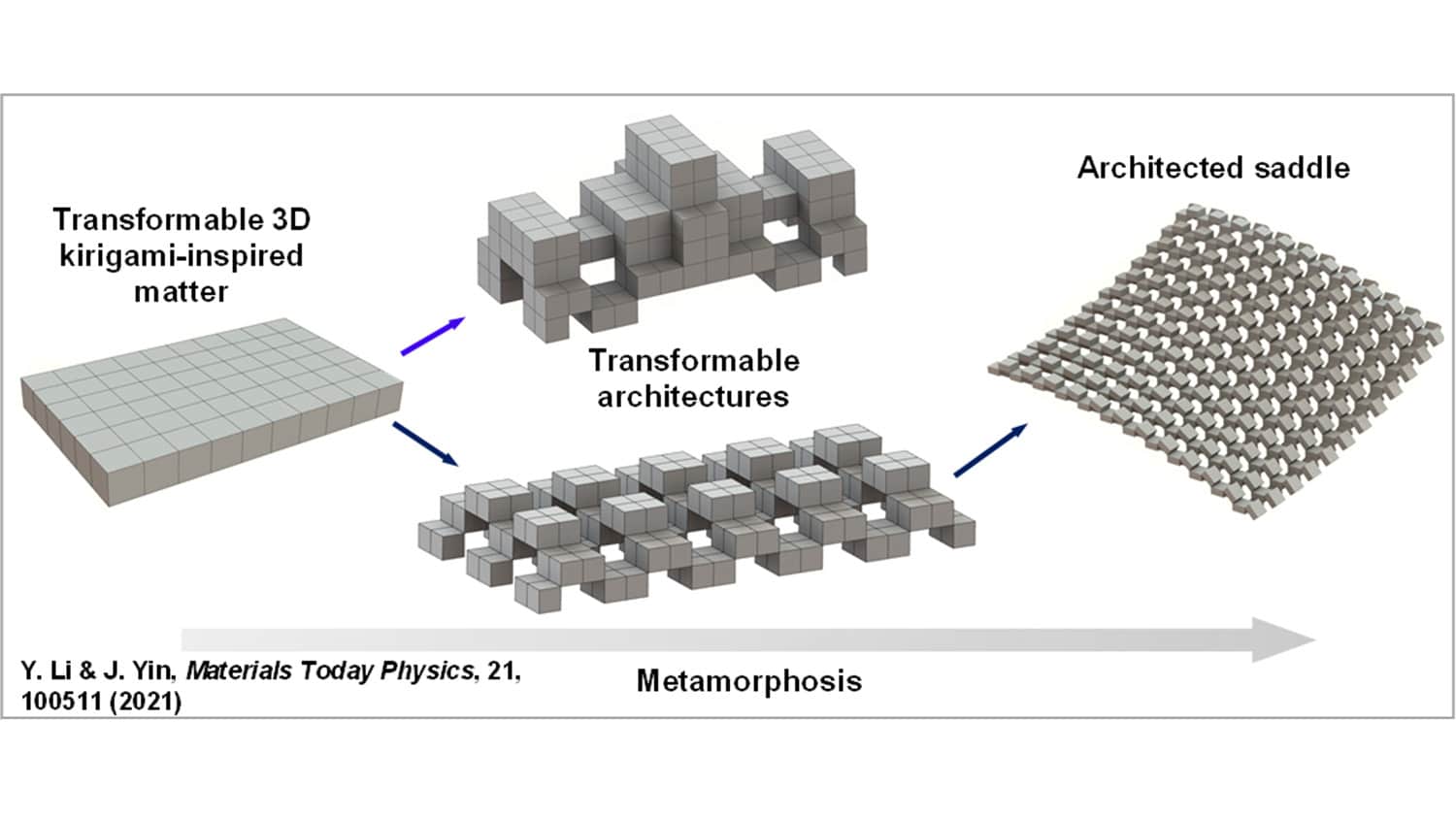Inspired by Metamorphosis, Researchers Create Materials For Shape-Shifting Architecture

For Immediate Release
Researchers at North Carolina State University have developed materials that can be used to create structures capable of transforming into multiple different architectures. The researchers envision applications ranging from construction to robotics.
“The system we’ve developed was inspired by metamorphosis,” says Jie Yin, corresponding author of a paper on the work and an associate professor of mechanical and aerospace engineering at NC State. “With metamorphosis in nature, animals change their fundamental shape. We’ve created a class of materials that can be used to create structures that change their fundamental architecture.”
Kirigami is a fundamental concept for Yin’s work. Kirigami is a variation of origami that involves cutting and folding paper. But while kirigami traditionally uses two-dimensional materials, Yin applies the same principles to three-dimensional materials.
The metamorphosis system starts with a single unit of 3D kirigami. Each unit can form multiple shapes in itself. But these units are also modular – they can be connected to form increasingly complex structures. Because the individual units themselves can form multiple shapes, and can connect to other units in multiple ways, the overall system is capable of forming a wide variety of architectures.
“Think of what you can build with conventional materials,” Yin says. “Now imagine what you can build when each basic building block is capable of transforming in multiple ways.”
Yin’s lab previously demonstrated a similar concept, in which 3D kirigami units were stacked on each other. In that system, the units could be used to assemble a structure – but the structure could also then be disassembled.
The metamorphosis system involves actually connecting the kirigami units. In other words, once the units are connected to each other they cannot be disconnected. However, the larger structures they create are capable of transforming into multiple, different architectures. Video of the metamorphosis system can be seen at https://www.youtube.com/watch?v=hOplS5J_wHI.
“There are two big differences between our first kirigami system and the metamorphosis system,” Yin explains.
“The first kirigami system involved units that could be assembled into architectures and then disassembled, which is an advantage. However, when the units were assembled, the architecture wouldn’t be capable of transforming. Because the sides of the unit were not rigid and fixed at 90-degree angles, the assembled structure could bend and move – but it could not fundamentally change its geometry.
“The metamorphosis kirigami system does not allow you to disassemble a structure,” Yin says. “And because the sides of each cubic unit are rigid and fixed at 90-degree angles, the assembled structure does not bend or flex very much. However, the finished structure is capable of transforming into different architectures.”
In proof-of-concept testing, the researchers demonstrated that the metamorphosis system was capable of creating many different structures that are capable of bearing significant weight while maintaining their structural integrity.
That structural integrity is important, because Yin thinks construction is one potential application for the metamorphosis system.
“If you scale this approach up, it could be the basis for a new generation of construction materials that can be used to create rapidly deployable structures,” Yin says. “Think of the medical units that have had to be expanded on short notice during the pandemic, or the need for emergency housing shelters in the wake of a disaster.”
The researchers also think the metamorphosis system could be used to create a variety of robotic devices that can transform in order to respond to external stimuli or to perform different functions.
“We also think this system could be used to create a new line of toys – particularly toys that can help people explore some fundamental STEM concepts related to physics and engineering,” Yin says. “We’re open to working with industry collaborators to pursue these and other potential applications for the system.”
The paper, “Metamorphosis of three-dimensional kirigami-inspired reconfigurable and reprogrammable architected matter,” is published in the journal Materials Today Physics. First author of the paper is Yanbin Li, a Ph.D. student at NC State. The work was done with support from the National Science Foundation, under grant 2005374.
-shipman-
Note to Editors: The study abstract follows.
“Metamorphosis of three-dimensional kirigami-inspired reconfigurable and reprogrammable architected matter”
Authors: Yanbin Li and Jie Yin, North Carolina State University
Published: Aug. 25, Materials Today Physics
DOI: 10.1016/j.mtphys.2021.100511
Abstract: Most shape-morphing materials are limited to one-to-one shape-changing process, i.e., one design corresponds to one target shape, thus it is hard to be reshaped due to the constraint of limited mobilities (degrees of freedom). Here, we propose harnessing kinematic bifurcation in mechanisms with multiple branched transformation paths to achieve enhanced reconfigurability and shape reprogrammability in a new class of 3D kirigami-inspired architected matter. The reconfigurable and reprogrammable architected matter is constructed from planar tessellation of 3D kirigami-inspired transformable modules. The module consisting of eight closed-loop connected cubes exhibits both 3D non-bifurcated and bifurcated transformation modes, the motions of which are well captured by the developed kinematics model. The modules can be periodically tessellated in plane to form a flat, thick panel in both a diluted (with voids) and compact (without voids) pattern with multiple encoded, compatible transformation modes. Consequently, it can undergo a series of consecutive shape changes by reconfiguring into varieties of 3D transformable architectures that are conceptually in analogy to metamorphosis in some living organisms during growth. The endowed rich mobilities are found to derive from the kinematic bifurcation. Among them, a unique transformed 3D architecture can be further reprogrammed to reconfigure into multiple architected shapes with zero and non-zero Gaussian curvature through both forward and inverse designs. Such 3D reconfigurable kinematic matter is attractive for potential applications in reconfigurable metamaterials and morphing architectures.


